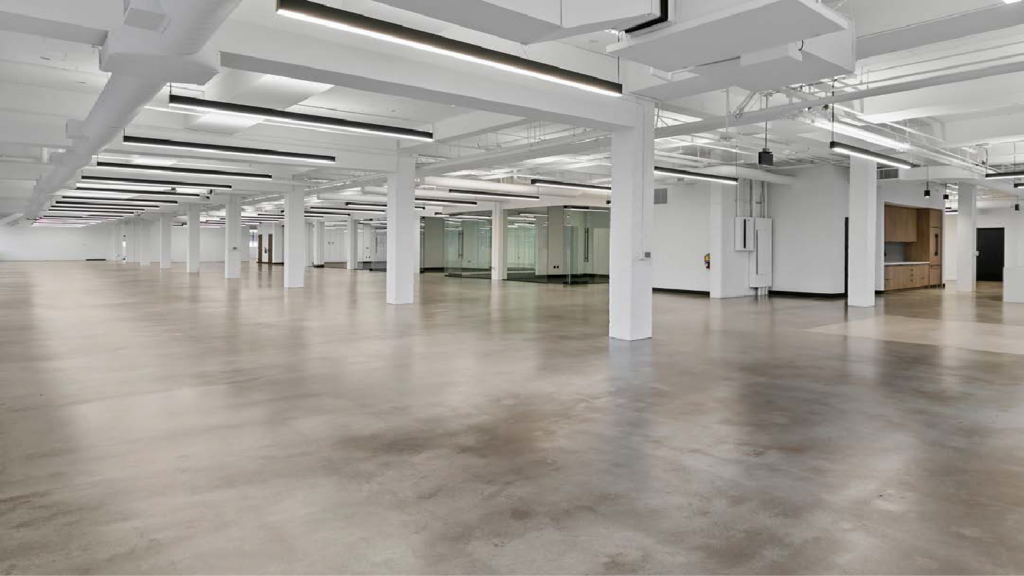Download the article here or read below.
Empty office buildings inspire the imagination. They are highly effective at what they do: providing clean, reliable, comfortable places for people to run businesses, provide counsel, and share ideas. These giant icons of American production have been home to nearly every major innovation for most of the 20th century and it’s difficult to separate that legacy from their potential. Office buildings are ubiquitous and, to the layman, not that fundamentally different than any other building. They were trusted to deliver hundreds of years of human-driven economic growth, so why not trust them with our most precious productivity tools today? Computers, after all, require far less attention than people do.
Data centers seem simple – plug in computers, turn on air conditioning, lock the doors. In the early days of the Internet, they were. Only giant telecom companies could afford the enormous facilities so small businesses and websites built their own infrastructure in whatever spare space their offices had. Although the salad days of Pentiums in closets hosting critical services are history, data centers have grown from a few monoliths dotting the horizon to mission-critical behemoths that house millions of digital tenants. They are hyper-scale, hyper-complex, and hyper-expensive. And they are hyper resource-hungry. Do they have to be?
The reliability of modern installations conceals their sophistication. Creating a stable environment for computers takes a spectacular amount of planning, power, space, and expertise. It’s not difficult to understand why data centers use a lot of electricity, but the rate at which they do it may be surprising. Over the course of a month, a standard desktop computer consumes about 12 kilowatts of electricity if it’s used 8 hours a day, producing 600 Btu of heat per hour. Stacked in racks of 42 like a data center, that’s more than 25,000 BTU every hour. For comparison, a standard household oil heater produces 5,200 BTUs on 1,500 watts. To put that in perspective, a building with 5,000 servers – often cited as a soft minimum for hyperscale centers – creates about the same amount of heat as a pile of 2,000 oil heaters all cranked to ‘max.’ Simply powering on the servers uses about a megawatt hour. The amount of energy required to remove that heat depends on a lot of different variables, but it is significant no matter what.
Investors hoping to repurpose empty office buildings should consider power their guiding light. “The international Energy Agency (IEA) estimates that global data center electricity use could double by 2026 and the challenge could be especially acute in areas of data center concentration like Loudoun County, VA” says Steve Weikal of the MIT Center for Real Estate. “Utilities will need to work with operators to predict demand, making sure that power production stays in phase with the grid. And developers will need to anticipate significant infrastructure requirements. It’s not as simple as running “industrial extension cords” from the neighbors. Expect extensive conversations with municipalities and impacted communities.” If a property can only barely meet today’s power requirements, it will have a limited useful life. The major players are so confident in this trend that they are making serious investments to secure their access. Not all data centers are seeking blue-chip, streaming powerhouse customers with super-sized power demands, but it is important to note that there is heavy consolidation in the industry and this is only the early dawn of the LLM sector.
Power is a tall hurdle in office conversion, but it isn’t insurmountable. Those that can clear it need to look closely at an array of infrastructure elements, one of which is also power. Manufacturers of the specialized cooling systems used in data centers have detailed specifications for the space and connections of their equipment, which could limit the number of servers that could be placed in a repurposed facility. Robust power handling and distribution equipment, such as transformers and panels, is a major boon in a possible conversion. Network connectivity is also extremely important. Both the lines in the building as well as the provider connection points will need to be capable of reliably transferring large amounts of data. Latency is measured in milliseconds, so proximity to a major internet exchange point will also be critical. Because many tenants consider their servers critical infrastructure, there is no such thing as acceptable downtime and this infrastructure all requires significant redundancy and resiliency. Service level commitments from utility providers and maintenance experts are critical to pair with this robust infrastructure.
It’s important to consider how many technical requirements are already in place when evaluating an asset for conversion to a data center. Cost savings is an outsize driver in office building conversions and retrofitting is a risky business, due limitations posed by building design and structure. Major challenges could materially change the financial viability of a project, or put a stop to it altogether. Although urban and residential-area commercial assets may seem to offer strong co-location benefits, or low lease rates, they may not engender community support. Fire codes often prohibit the use of large batteries (of the type required for redundancy in data centers) and the alternative, generators, are extremely noisy. At one government property in Northern Virginia, residents immediately started lodging complaints the month it went “online.” The resultant outcry was so significant, the facility was bound to a strict schedule of quiet hours. Similarly, aspiring operators need to navigate a complex system of entitlements, regulations, zoning, building cope, and compliance issues which govern data center construction and environmental standards.
Some challenges are manageable and they are often packaged with opportunities to make green choices. Because of the high-power demands and need for redundancy, investors will want to investigate the renewable energy sources in their region. Diversifying power supplies also carries with it the benefit of more reliable power and reducing the chances of cascade or large-scale failure. Renewables also increase power usage effectiveness; by increasing the number of tasks that can be handled by sporadic energy sources, consistent utility energy can be used for more mission critical operations while also lowering costs. Green improvements may also make valuable headway towards carbon goals.
Conversion of existing properties into vertical data centers may seem like a herculean task, but the real question may be “compared to what?” Construction of a modest 100,000-square-foot data center would take years and be costly and may not deliver the results customers need. High frequency trading firms, for example, spend tens of millions of dollars per year on improving latency, so the amount of money involved may not be as big of a hurdle as the technical challenges a favorable location could resolve. Conversions could offer superior cost savings, speed to market, and sustainability. Some areas, such as those with underserved event venues or emerging technology sectors, could consider temporary or triage installations to meet surge demand. Successful ventures will understand the market niche they plan to fill before touring sites.
If the math works, here are a few key areas to evaluate at any potential site:
Power Infrastructure
- Electrical Capacity: The building should have sufficient electrical capacity to support the data center’s power needs, including both current and future requirements.
- Redundancy: Redundant power sources, such as multiple utility feeds or backup generators, are essential to ensure continuous operation in the event of power outages.
- Power Distribution: Adequate power distribution infrastructure, including reliable transformers and distribution panels, is crucial for efficiently delivering power to data center equipment.
Cooling and HVAC Systems
- Cooling Capacity: The building should have the capability to support the cooling requirements of data center equipment, including air conditioning or more advanced cooling technologies.
- Redundancy in Cooling: Redundant cooling systems and environmental controls are essential to maintain optimal operating temperatures and prevent equipment overheating.
Space and Layout
- Floor Load Capacity: The building’s structure should support the weight of data center equipment, including servers, cabinets, and cooling systems. Ceiling Height: Sufficient ceiling height is necessary for the installation of raised floors, overhead cabling, and proper airflow management.
- Column Spacing: Adequate column spacing allows for efficient equipment layout and ease of movement within the data center space.
Security
- Physical Security: The building should have robust physical security measures, including access control systems, surveillance cameras, and secure entry points, to protect data center assets.
Connectivity
- Network Infrastructure: The building should have access to high-speed and redundant network connections to ensure seamless connectivity for data transfer and communications.
- Carrier Neutrality: Being carrier-neutral allows flexibility in choosing multiple network service providers, enhancing redundancy and reliability.
Regulatory Compliance
- Zoning and Building Codes: The building must comply with local zoning regulations and building codes applicable to data center operations.
- Environmental Compliance: Compliance with environmental regulations, including proper disposal of electronic waste and adherence to energy efficiency standards, is essential.
Scalability
- Room for Expansion: The building should provide room for future expansion, enabling the data center to scale its infrastructure as demand grows.
- Modularity: A modular approach to infrastructure design allows for easier and more cost-effective scalability.
Accessibility
- Proximity to Network Hubs: Ideally, the building should be located close to telecommunication network hubs to reduce latency and improve network performance.
Environmental Considerations
- Green Building Features: Consideration of energy-efficient and sustainable building features aligns with environmental goals and may contribute to operational cost savings.
Fire Suppression:
- Effective fire detection and suppression systems are critical to safeguard against potential fire hazards.
These variables just scratch the surface of the things investors should consider. Since every case is different, perhaps the most valuable asset one can have is an experienced partner. Colliers data center, engineering, and design professionals have ground-up, hands-on experience and can help with every step of the process. No matter where you are in the process, from conducting feasibility studies to working on efficiency projects for running centers, our professionals can provide valuable guidance. To get started, contact Chris Petosa, who leads Colliers data center management team, at chris.petosa@colliers.com.

 Andrew Steele
Andrew Steele

 Sheena Gohil
Sheena Gohil Bob Shanahan
Bob Shanahan Dougal Jeppe
Dougal Jeppe Kai Shane
Kai Shane
 Bret Swango, CFA
Bret Swango, CFA Michelle Cleverdon
Michelle Cleverdon
 Aaron Jodka
Aaron Jodka